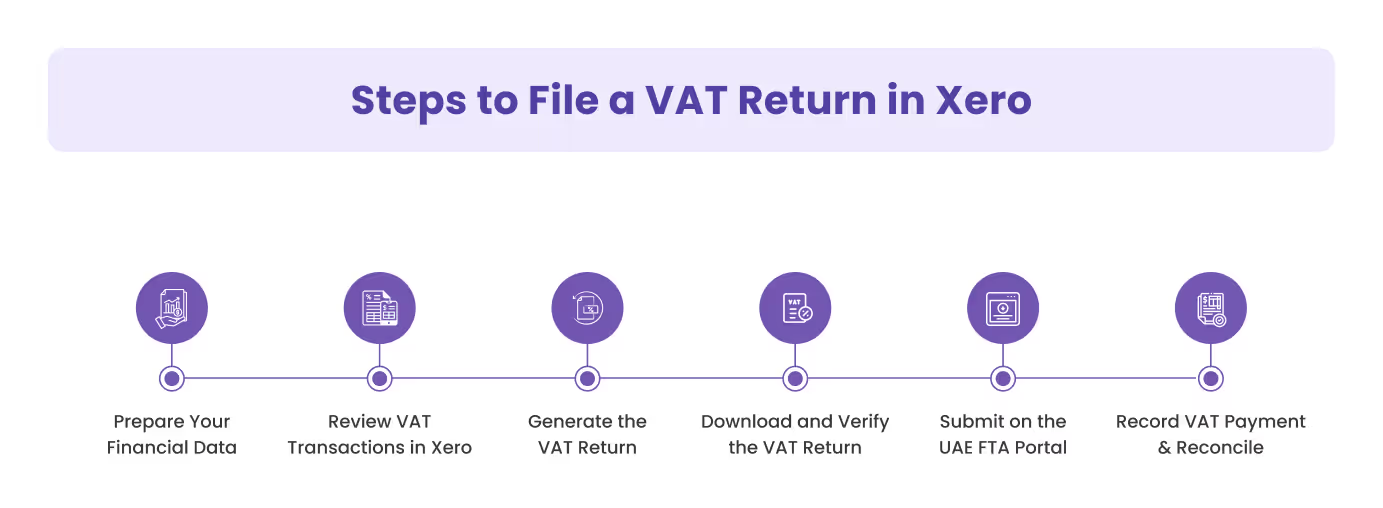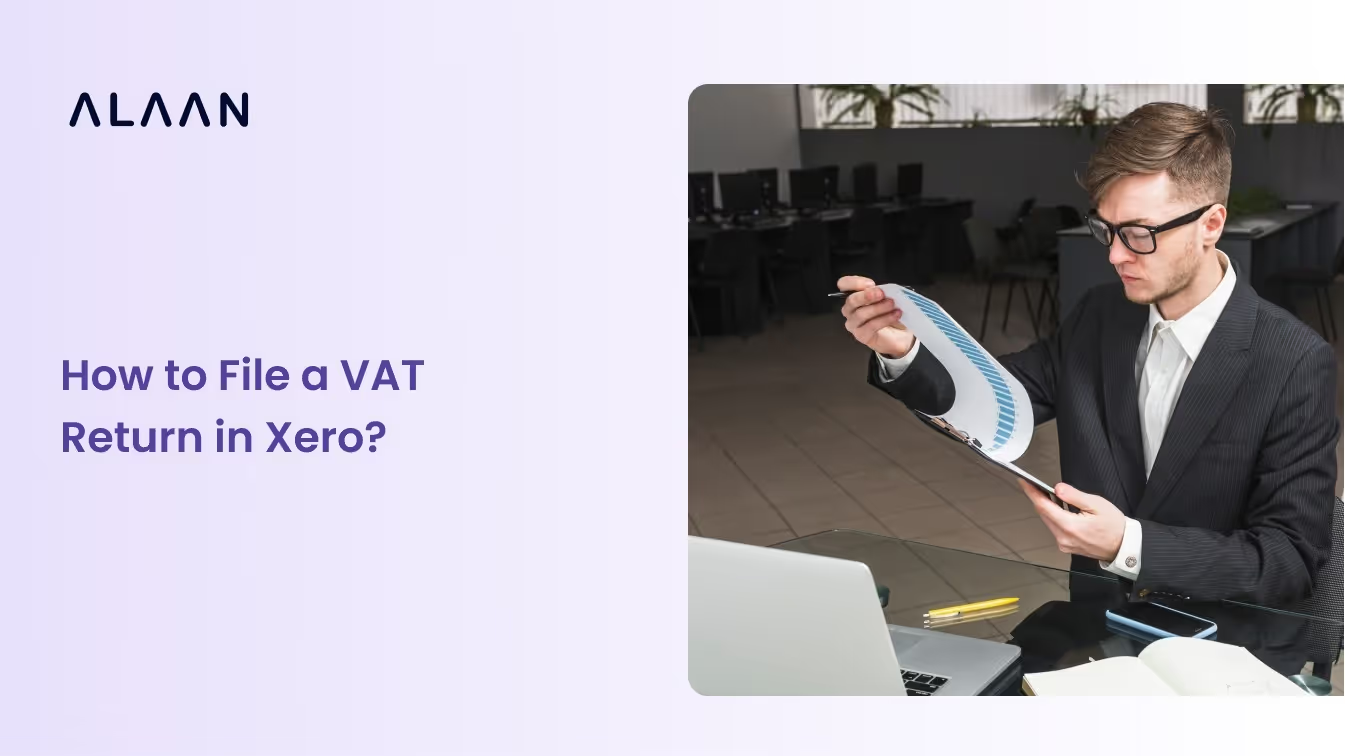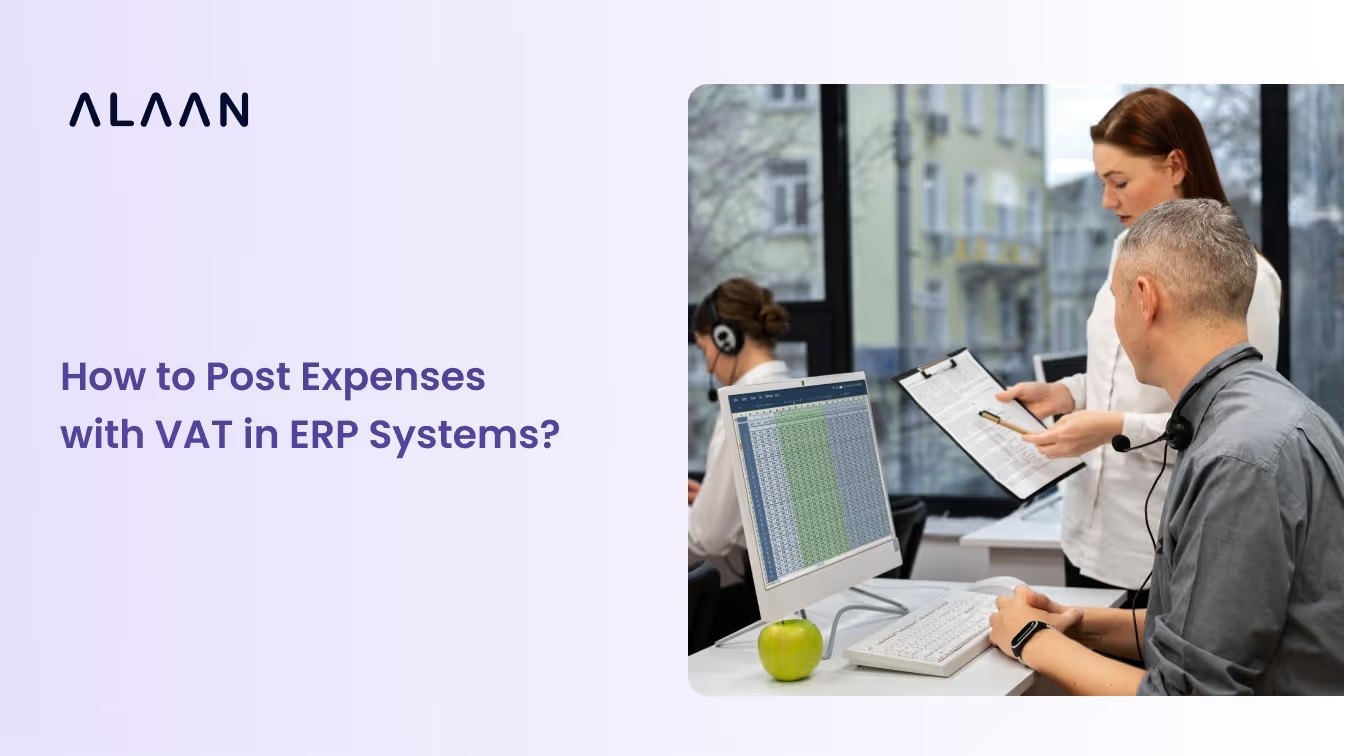Since the UAE introduced VAT in 2018, regulatory expectations around tax filing have become more stringent, with over 312,000 businesses now registered and subject to routine compliance checks. Filing VAT returns accurately and on time isn’t just a box-ticking exercise; it’s essential to avoid penalties, maintain operational transparency, and uphold trust with regulatory bodies.
For finance leaders and accountants using Xero, navigating the VAT return process efficiently is a key part of monthly and quarterly workflows. But many still face challenges in coding transactions correctly, reconciling reports, and ensuring full compliance with Federal Tax Authority (FTA) guidelines.
This guide provides a clear, step-by-step breakdown of how to file VAT returns using Xero, especially for the specific needs and regulations faced by businesses operating in the UAE and the wider MENA region.
Key Takeaways
- Accurately categorise and reconcile all VAT-related transactions in Xero per UAE and MENA regulations.
- Follow a precise step-by-step VAT filing process within Xero to ensure compliance and audit readiness.
- Retain all VAT invoices and supporting documents for a minimum of five years as required by law.
- Use integrations like Alaan to automate VAT data capture, coding, and reporting for enhanced accuracy.
- Submit VAT returns and payments on time via the FTA portal to avoid substantial fines and penalties.
- Regularly update Xero settings to reflect regulatory changes and avoid common filing errors.
How to File a VAT Return in Xero: Step-by-Step Guide

Filing VAT returns in Xero for businesses in the UAE or MENA requires strict adherence to FTA guidelines. Each tax period, finance teams must consolidate taxable sales, purchases, and adjustments and reconcile them within Xero. Ensuring these are correctly coded and documented can help avoid fines of AED 1,000 or more per error or late submission.
Below is a stepwise process to master how to submit VAT return Xero:
Step 1: Prepare Your Financial Data
All transactional data must be captured accurately in Xero prior to VAT return initiation. Finance teams should verify that each sales invoice, purchase bill, and expense entry corresponds to the correct VAT period, and confirm all amounts and counterparties are correct per UAE compliance protocols.
Thorough preparation is critical to prevent later regulatory penalties.
- Ensure all revenue and expense transactions for the applicable VAT period are posted in Xero, with each linked to the correct tax codes (e.g., standard 5% VAT, zero-rated, exempt).
- Validate supplier and customer TRNs (Tax Registration Numbers) in all records, matching these to FTA registration databases where possible.
- Reconcile all bank accounts to ensure no transactions are omitted or misclassified; use bank statements, import/export documentation, and internal ledgers as cross-references.
- Confirm all tax invoices contain the statutory fields required under UAE law, including VAT registration and sequential invoice numbering.
[cta-6]
Step 2: Review VAT Transactions in Xero
The VAT Audit Report in Xero enables a detailed review of all transactions affecting VAT liability, identifying potential errors before final return generation.
Careful transaction audit in Xero ensures that all data is compliant and reflective of real business activity. For that:
- Generate the VAT Audit Report and filter for anomalies such as missing VAT code assignments or transactions showing “No VAT.”
- Isolate and examine all transactions with zero-rated, exempt, or out-of-scope codes; check against contracts and regulatory definitions to confirm status.
- Compare period-on-period VAT movement; investigate significant fluctuations in VAT amounts which may signal error or misposting.
- Address irregularities immediately by correcting codes or revisiting source documentation before progressing.
Also Read: How To File VAT Returns in the UAE?
Step 3: Generate the VAT Return
Once transactions are reviewed, Xero can auto-generate your VAT return using the correct UAE tax period settings.
- Go to Accounting → VAT Return in Xero.
- Select the exact tax period issued by the FTA — this must align with your VAT registration cycle (monthly or quarterly).
- Review each section of the return:
- Box 1 – Standard-rated supplies
- Box 3 – Reverse charge supplies (if applicable)
- Box 14 – Net VAT payable or refundable
If you’ve made any manual adjustments, document the reason and retain all supporting evidence for audits.
⚠️ Do not submit the return until all anomalies are corrected and each figure is verified.
Step 4: Download and Verify the VAT Return
Before submission, the VAT return must be thoroughly checked, exported, and internally reconciled with base data.
Strict verification of the computed VAT return prevents fines and audit exposure.
- Export the VAT return as a PDF/Excel, maintaining the FTA’s preferred file structure and nomenclature.
- For each value, especially net VAT due (Box 14), trace back to the underlying sales and purchase ledgers; confirm totals reconcile.
- Compile and retain an audit pack: invoices, receipts, reconciled bank statements, and export/import documentation, as legally required for a minimum of five years in the UAE.
- Any detected errors must be corrected in Xero; rerun the return prior to submission.
Step 5: Submit on the UAE FTA (or Local Authority) Portal
Submission on EMARATAX (UAE) requires precise data entry and document retention, in alignment with the latest e-services guidelines.
Portal submission is a regulated, auditable transaction; accuracy and timely compliance are important.
- Log in to the FTA portal; access VAT > My Filings > File for the relevant period.
- Either transcribe the VAT return figures manually or (if integration exists) upload the Xero-generated file into the portal's template.
- Confirm all portal fields pre-populated from previous periods and cross-check against your Xero report; edit as required for new inputs, adjustments, or corrections.
- Upon completion, download and archive the submission confirmation/receipt and any automated acknowledgement issued by the authority.
- Save all supporting documents, VAT return files, and FTA receipts per regulatory requirements for future audit or review.
Note that EmaraTax currently does not have direct API integration with Xero, so manual entry or Excel-based uploads are still common.
Step 6: Record VAT Payment and Reconcile
VAT liabilities must be paid by strict statutory deadlines, typically the 28th-day post-period, with reconciliation to internal ledgers upon settlement.
Prompt, documented payment helps avoid late penalties and builds a strong compliance trail.
- Initiate payment to the FTA using tightly controlled channels (eDirham, approved bank transfer, stick to details from the official FTA notification).
- Post and reconcile the VAT payment transaction in Xero, matching the payment to the VAT Control Account and referencing the transaction ID from the FTA or bank.
- Archive the bank advice and payment confirmation; update your finance team’s compliance files.
- Consistently verify that the paid VAT matches the submitted net VAT due, tracking any discrepancies or refunds due across subsequent periods.
Application of these steps guarantees that every stage of VAT return preparation, review, submission, and payment aligns precisely with UAE compliance mandates, significantly reducing enforcement risk.
Also Read: Filing and Making VAT Payments in UAE
To enhance the accuracy and efficiency of your VAT return process in Xero, focus on these additional tips to optimise compliance and minimise errors.
[cta-8]
Additional Tips to File VAT Return in Xero
Finance leaders and CFOs in the UAE and across the MENA region operate in a regulatory landscape where a single error or omission in a VAT return can trigger fines ranging from AED 1,000 to 3,000, as well as unwanted scrutiny from the Federal Tax Authority.
Here are some proven tips to enhance compliance outcomes for regionally regulated businesses.
- Use Automated VAT Calculations—But Validate Manually
Xero’s automated VAT computation functions reduce errors and accelerate reporting. However, always manually validate VAT figures against the FTA’s specific return lines (Boxes 1 to 14 on VAT 201) before submission to ensure no misclassification or software-specific anomaly passes through. Cross-check standard-rated, zero-rated, and exempt categories every period.
- Customise Xero’s Tax Codes to Match UAE VAT Categories
Adapt Xero’s default tax rate configuration to specifically align with regionally mandated VAT classifications, including standard-rated (5%), zero-rated, exempt, and reverse charge mechanisms.
This ensures output tax and input credit are reported correctly, including sectors such as financial services, exports, and designated free zones.
- Integrate with FTA-Compliant Add-Ons for Localised Reporting
Xero’s core reporting can require manual adjustments to address regional regulatory nuances.
Employ integrations, like Alaan, that provide FTA-compliant templates and workflows for rapid, accurate localisation of VAT return data, supporting seamless file formatting, upload, and audit trails.
- Maintain Documentary Evidence and Ensure Full Audit Trail
Retain digital copies of all VAT invoices, tax credit notes, contracts, and supporting calculations for at least five years as mandated by UAE law.
Systematically reference internal documentation and scanned invoices to every VAT return record in Xero for easy retrieval during FTA audits.
- Manage Special Scenarios: Imports, Designated Zones, and Reverse Charges
Ensure correct VAT treatment for imports. Implement Xero workflows that separately capture imports under the reverse charge mechanism, as required for cross-border transactions.
For designated zones/free zones, recognise when transactions are outside the UAE VAT scope and adjust Xero coding accordingly.
To support you in the FTA-compliant VAT process, specialised UAE fintech solutions deliver powerful automation and integration features. One standout is Alaan, which significantly extends Xero’s compliance capabilities for regional businesses.
How Alaan Helps File VAT Returns in the UAE
Alaan, a leading provider of spend management solutions, offers a direct, FTA-aligned pathway for VAT management and return filing customised for UAE regulatory frameworks.
Here are the ways Alaan can simplify your VAT filing in the UAE:
- Real-Time VAT Data Capture: Alaan automatically extracts VAT information—such as supplier TRNs, invoice dates, VAT amounts, and invoice numbers—from receipts, invoices, and card transactions.
This data is mapped and pushed directly into your accounting system, ensuring end-to-end accuracy while eliminating the risk of missed fields or incorrect claims.
- Automated Expense Coding and Controls: Each transaction is classified at the point of spend, not retroactively. Alaan applies predefined rules to match spend categories with the correct VAT codes, and flags non-recoverable or out-of-policy items instantly.
This built-in control reduces compliance risk and prevents misclaims—one of the leading causes of FTA penalties.
- Seamless Integration with Xero: Alaan natively integrates with Xero, syncing transactions, VAT data, and supporting documents in real time.
Expenses are automatically aligned with the correct VAT period and supplier records, eliminating duplicate entries and ensuring books are clean, consistent, and audit-ready.
Use Alaan in conjunction with Xero to streamline every aspect of the VAT lifecycle. Schedule a free demo today to know how Alaan can assist you with your VAT processes.
Wrapping Up,
Accurately filing your VAT return in Xero is not just about avoiding fines—it’s about building a strong, reliable tax infrastructure for your business. In a high-compliance market like the UAE, where the FTA is enforcing stricter digital audits and real-time reporting expectations, accuracy, automation, and audit-readiness are non-negotiable.
By following a structured, step-by-step process, from reconciling transactions to submitting returns via the FTA portal, you ensure every filing is complete, compliant, and defensible.
But to truly eliminate manual effort and reduce risk, integrating tools like Alaan can transform your VAT lifecycle:
- Every expense is auto-coded with the right VAT rules
- Every transaction is linked to receipts and supplier TRNs
- Every report is aligned with the UAE VAT Form 201 requirements
- Every audit trail is ready, without needing to chase documents
At Alaan, we’re helping UAE finance teams automate compliance, reduce filing errors, and stay ahead of evolving regulations—all while saving hours each cycle.
Book a free demo to explore how Alaan pairs with Xero to simplify your VAT return process from start to finish.
[cta-9]
Frequently Asked Questions (FAQs)
1. What are the consequences of submitting a late or inaccurate VAT return in the UAE?
Late or incorrect VAT returns result in significant financial penalties. For late submissions, the Federal Tax Authority imposes a fine of AED 1,000 for the first offence and AED 2,000 for repeated offences within 24 months. Submission of an inaccurate return can attract a penalty of AED 3,000, increasing to AED 5,000 for subsequent offences.
2. How can errors in a previously submitted VAT return be corrected through Xero?
If an error is detected after submission, and the error is below AED 10,000, the adjustment should be made in the next VAT return. For errors exceeding AED 10,000, businesses must file a Voluntary Disclosure (Form 211) via the FTA’s EmaraTax portal, accompanied by supporting documentation.
3. What supporting documentation must be retained for each VAT return, and for how long?
UAE law requires all businesses to retain complete supporting documentation, including tax invoices, credit notes, contracts, and related correspondence, for a minimum of five years. Imports, exports, standard, zero-rated, and exempt supplies all require source documentation that can be provided to the FTA upon request for audit or review.
4. Are VAT refunds available, and what are the common challenges in claiming them?
VAT refunds can be claimed when input tax exceeds output tax for a period, leading to a refundable surplus. Key challenges include providing transaction-level documentation, reconciling returns with accounting records, and justifying zero-rated or out-of-scope supplies.
5. What should I do if I experience technical issues when accessing or submitting VAT returns in Xero?
Technical issues, such as “VAT Return Load Error” or inability to access filing sections, typically require troubleshooting steps such as clearing browser cache, testing alternate browsers, and checking system updates.
6. How often should VAT exports be reviewed or re-posted?
VAT exports should be reviewed for accuracy and compliance at each VAT return period, typically quarterly or monthly, as required by the UAE Federal Tax Authority. Re-posting is mandatory if updates arise, especially regarding export documentation or zero-rating eligibility. Regular reviews reduce compliance risks and potential penalties.


.avif)






